Intercity (Deutsche Bahn)
 | |
|
A DB Intercity train near Minden in 2012 | |
| Locale | Germany |
|---|---|
| Dates of operation | 1971– |
| Predecessor | F-Zug |
| Track gauge | 1,435 mm (4 ft 8 1⁄2 in) |
| Website | www.bahn.com |
Intercity is the second-highest train classification in Germany, after the ICE. Intercity services are loco-hauled express services, usually over long-distances. There are Intercity routes throughout Germany, and routes generally operate with a two-hour frequency, with multiple routes giving a more frequent service on core routes. Intercity services are operated by the DB Fernverkehr sector of Deutsche Bahn.
The Intercity name was introduced in Germany in 1971, replacing the old F-Zug category, and was the top category of train in Germany until the introduction of the ICEs in the early 1990s. With the proliferation of ICE services, the role of IC trains has diminished slightly, and they have taken on the character of many former InterRegio trains. Nonetheless, Intercity trains still offer a very high standard of speed and comfort – all services convey first class accommodation, and most include catering – usually a Bistro Cafe, but some services include a restaurant. A number of Intercity services serve destinations outside of Germany; most of these are under the EuroCity classification.
History
Inception

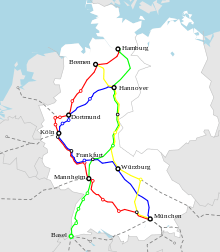
The idea for Intercity services on the Deutsche Bundesbahn network was first proposed in 1967, inspired by the success of British Rail's InterCity brand. After some planning, the proposal was approved in 1969, and the services were finally introduced in September 1971, after some delays in delivery of new coaching stock. The original network consisted of four lines, operating every two hours, and connecting the largest cities in West Germany. At this time, Intercity trains were first-class only. The original lines were:
- Line 1 (red): Hamburg-Altona – Bremen – Münster (Westf) – Dortmund – Essen – Duisburg – Düsseldorf – Köln – Bonn – Koblenz – Mainz – Mannheim – Heidelberg – Stuttgart – Ulm – Augsburg – Munich
- Line 2 (blue): Hannover – Bielefeld – Hamm – Dortmund – Hagen – Wuppertal-Elberfeld (– Solingen-Ohligs) – Köln – Bonn – Koblenz – Wiesbaden – Frankfurt (Main) – Würzburg – Nürnberg – Augsburg – München
- Line 3 (green): Hamburg-Altona – Hannover – Göttingen – Fulda – Frankfurt (Main) – Mannheim – Karlsruhe – Freiburg (Breisgau) – Basel
- Line 4 (gold): Bremen – Hannover – Göttingen – Bebra – Fulda – Würzburg (– Ingolstadt) – Munich
Gradually, the Intercity network started to expand, and with the introduction of the Class 103 locomotives, 200 km/h running was possible. Services were increased in frequency to hourly, and second class accommodation was provided – in 1979 this was promoted with the slogan "every hour, every class".
Additionally, there is also another new line 5, running from Dortmund to Munich. It was opened since 2 May 1985.
- Linie 1 (red): Hamburg-Altona – Bremen – Osnabrück – Münster (Westf) – Dortmund – Bochum – Essen – Duisburg – Düsseldorf – Köln – Bonn – Koblenz – Wiesbaden – Frankfurt (Main)
- Linie 2 (brown): Hannover – Bielefeld – Hamm – Dortmund – Essen – Duisburg – Düsseldorf – Köln – Bonn – Koblenz – Mainz – Mannheim – Heidelberg – Stuttgart – Ulm – Augsburg – München
- Linie 3 (green): Hamburg-Altona – Hannover – Göttingen – Fulda – Frankfurt (Main) – Mannheim – Karlsruhe – Freiburg (Breisgau) – Basel (– Schweiz)
- Linie 4 (gold): Hamburg-Altona – Hannover – Göttingen – Bebra – Fulda – Würzburg – Augsburg – München
- Linie 4a (grey): Oldenburg bzw. Bremerhaven – Bremen – Hannover
- Linie 5 (blue): Dortmund – Hagen – Wuppertal-Elberfeld (– Solingen-Ohligs) – Köln – Bonn – Koblenz – Mainz – Frankfurt (Main) Flughafen – Frankfurt (Main) (– Aschaffenburg) – Würzburg – Nürnberg – Augsburg – München
The InterCity for 3a is also part of the TransEuropExpress:
- Linie 3a: Amsterdam – Utrecht – Oberhausen – Duisburg – Düsseldorf – Köln – Bonn – Koblenz – Mainz – (Mannheim – Karlsruhe – Freiburg (Breisgau) – Basel) or (Mannheim – Heidelberg – Stuttgart – Ulm – Augsburg – München – Salzburg) or (Frankfurt (Main) airport – Frankfurt (Main) – Würzburg – Augsburg – München – Innsbruck)
Some ICs switched between lines 4 and 5, 2 and 5 (Essen or Wuppertal), or 2 and 3 (Basel or Stuttgart).
Reunification and growth


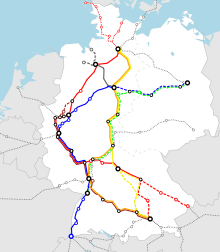
The network continued to evolve throughout the 1980s, and in the early 1990s it saw major changes. One major driving force for this was German reunification, which saw the network expand across the former East Germany, but also the opening of two high-speed lines in 1991: Mannheim to Stuttgart and Hannover to Würzburg. The first generation ICEs were introduced around this time, and took over most services on the Hannover – Fulda corridor, while the remaining services expanded in all directions.
The routes on 2 June 1991 were as follows:
- IC-Linie 1 (red): Hamburg-Altona – Bremen – Münster (Westf) – Dortmund – Essen – Duisburg – Düsseldorf – Köln – Bonn – Koblenz – Mainz – Frankfurt (Main) Flughafen – Frankfurt (Main) – Aschaffenburg – Würzburg – Nürnberg – (Ingolstadt – Munich) or (Regensburg – Passau – Linz – Wien) (connecting to Austria)
- IC-Linie 1a (magenta): Wiesbaden – Frankfurt (Main) (two hourly)
- IC-Linie 2 (brown): (Dortmund – Bochum) or (Münster (Westf) – Recklinghausen – Gelsenkirchen) – Essen – Duisburg – Düsseldorf – Köln – Bonn – Koblenz – Mainz – Mannheim – Heidelberg – Stuttgart – Ulm – Augsburg – Munich (acht EC-Zugpaare above Salzburg to Budapest, Klagenfurt, Wien or Zagreb)
- IC-Linie 2a (magenta): Wiesbaden – Mainz
- IC-Linie 3 (green): Berlin – Potsdam – Magdeburg – Helmstedt – Braunschweig – Hildesheim – Göttingen – Kassel-Wilhelmshöhe – Fulda – Frankfurt (Main) – Mannheim – Karlsruhe (zweistündlich, ein EC-Zugpaar above Basel to Zürich)
- IC-Linie 4 (gold): Hamburg-Altona – Hannover – Göttingen – Kassel-Wilhelmshöhe – Fulda – Würzburg – Augsburg – München (every two hours to Nürnberg)
- IC-Linie 5 (blue): (zweistündlich Berlin – Potsdam – Magdeburg –) Braunschweig – Hannover– Bielefeld – Hamm – Dortmund – Hagen – Wuppertal – Solingen-Ohligs – Köln – Bonn – Koblenz – Mainz – Mannheim – Karlsruhe – Freiburg (Breisgau) – Basel (new EC pairs of trains nach Brig, Chur, Genf, Interlaken, Mailand oder Sestri Levante)
- EC-Linie 5a (lilac): Amsterdam – Utrecht – Emmerich – Oberhausen – Duisburg – Düsseldorf – Köln (zweistündlich, zwei EC-Zugpaare der Linie 5 to Chur and Interlaken)
- ICE-Linie 6 (orange): Hamburg-Altona – Hannover – Göttingen – Kassel-Wilhelmshöhe – Fulda – Frankfurt (Main) – Mannheim – Stuttgart – Ulm – Augsburg – München
- IC-Linie 6a (grey): Oldenburg or Bremerhaven – Bremen – Hannover
Meanwhile, a new type of express train – the InterRegio – was created in the late-1980s, replacing the old D-Zug, providing semi-fast services to complement Intercity trains.
Modern era
The next major change to Intercity services came about in 2002, with the opening of the Cologne–Frankfurt high-speed rail line largely to replace the West Rhine Railway, a major trunk route for Intercity services. While previous high speed lines in Germany had been designed for mixed usage, and could be used by Intercity trains, this line can only be operated by new ICE 3 units. This, along with the introduction of another generation of ICEs, the ICE T, saw large numbers of Intercity routes converted to ICE. Meanwhile, the InterRegio classification was abolished, and many of its services converted into Intercity routes.
As a result, the character of Intercity has changed. Having been on an almost equal footing with the ICE, it is very much secondary. While it still provides a high quality of service, trains now stop more frequently, and are more commonly found on lesser routes. Most current IC trains convey fewer first-class coaches, more open seating as opposed to compartments, and a Bistro Cafe (buffet car) instead of a restaurant or no on-board catering at all, although this is as much a reflection of the changing habits of modern passengers than it is a change in the status of Intercity trains. Lines 30 and 31 – Hamburg to Frankfurt/Stuttgart are the closest in character to a 'classic' Intercity train.
Current services
Below are the current services in the 2014 timetable.
Named services
Originally, all Intercity services had names, usually named after a famous figure from one of the cities along the route. Nowadays, fewer services are named, usually those that serve the extremities of the rail network. Names are usually taken from a geographical location along the route.
Rolling stock
Motive power
The original Intercity services were hauled by the Class 103 electric locomotives, built in the early-1970s and capable of 200 km/h. Lesser routes were operated by Class 110 and 111 locos, but these had a lower maximum speed, and with line speeds increasing, their use became untenable. A new Class 120 was introduced in 1987, and these classes were relegated to Regional duties. In the mid-1990s the Class 101 was introduced, and these locomotives now dominate Intercity services, with the 103s having been largely retired in the early-2000s.
On non-electrified Intercity routes, such as Hamburg to Westerland, or Ulm to Lindau, Class 218 diesel locomotives are used, usually double-headed. For cross-border services, multi-voltage electric locos are needed, such as the Class 181 to France and Luxembourg or the Class 180 into the Czech Republic and Poland.
After German reunification, former Deutsche Reichsbahn locomotives could be found on Intercity services – not only the Class 180s, but the 112 (electric) and 219 (diesel) locos. While the 219s have been retired, the 112s are now solely used on Regional-Expresses due to their top speed of 160 km/h.
While most Intercity trains have been loco-hauled, a small number of services have been operated by multiple units: early services were operated by the VT 11.5 and Class 403 TEE units, while Nuremberg to Dresden route, was briefly operated by Class 612 DMUs in Intercity livery. This service is now classified as an Interregio-Express (part of DB Regio) and the units are back in standard DB red.
Gallery
| Current motive power | ||||
|---|---|---|---|---|
 |
 |
 |
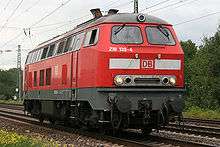 | |
| 101 (Electric loco) | 120 (Electric loco) | 180 (Multi-voltage electric loco) | 181 (Multi-voltage electric loco) | 218 (Diesel loco) |
Coaching stock
Early Intercity trains used classic Eurofima stock, shared with TEE and D-Zug expresses, but with the growth of the network in the 1980s, and the inclusion of second class, large numbers of new air-conditioned coaches were built, which are still in use to this day. In the mid-1990s driving trailers were introduced on Intercity and Interregio services, which had the effect of speeding up journey times: many major German railway stations are termini, so a lot of Intercity services include at least one change of direction. With the demise of Interregio in 2002, a large number of IR coaches were incorporated in Intercity services – particularly second class coaches but also the Bistro Café, which has replaced a full restaurant on most routes.
Formations
Intercity trains are usually 7 to 11 coaches long, depending on the route. There are one or two first class coaches – one compartment coach, and one open on longer trains. A few routes still use restaurants, but most use a bistro cafe, which also provides half a coach of first-class accommodation. Most of the second class coaches are open, but with some compartments, and some ex-Interregio coaches. Cycle space is provided by the driving trailer, but these are not used on all routes, so there are some non-driving coaches with space for bicycles.
Livery
Intercity coaches were originally in the blue and beige colour scheme employed on D-Zug services, with first class coaches in the TEE dark red and beige. A rebranding of the Deutsche Bundesbahn in the mid-1980s saw a new colour scheme for Intercity services, orient red and light grey with a pastel pink stripe in between. When DB adopted traffic red as its corporate colour in the mid-1990s, this replaced orient red, with the pink stripe taken off, before a new livery was introduced in 2000s – based on the Intercity-Express, the coaches are all white with a red stripe.
Refurbishment
In 2012, DB began a programme of refurbishing the interior its Intercity coaches with decor similar to that found in the ICE3. Name of the programme is IC mod.[6] The work is expected to be completed by 2014.
Overview
| Image | Description | Classification | Interior | Refburbished interior |
|---|---|---|---|---|
 |
1st class open | Apmz |  |
|
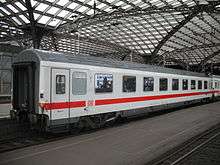 |
1st class compartment | Avmz |  |
|
 |
Bistro Café / 1st class compartment & open (ex-InterRegio) | ARkimbz |  |
|
 |
Restaurant | WRmz |  |
|
 |
2nd class open | Bpmz |  |
|
 |
2nd class open with wheelchair space | Bpmbz | ||
 |
2nd class compartment & open, train conductor compartment, baby compartment | Bvmsz |  |
|
| 2nd class compartment & open | Bvmz |  |
||
 |
2nd class compartment (former 1st class) | Bwmz | ||
 |
2nd class compartment & open (ex-InterRegio) | Bimz |  |
|
 |
2nd class compartment & open with cycle space (ex-InterRegio) | Bimdz |   |
|
| 2nd class compartment & open driving trailer (ex-Inter Regio) | Bimdzf | |||
| 2nd class driving trailer | Bpmbdzf |
Future rolling stock
Deutsche Bahn plans to replace most Intercity and Eurocity rolling stock with Intercity-Express ICE 4 electric multiple unit trainsets by 2025.[7] ICE 4 is a Deutsche Bahn project to procure up to 300 fourth generation Intercity-Express trains to replace its existing Intercity fleets used on long-distance passenger services in Germany.[8]
In addition to the ICE 4, Deutsche Bahn has awarded Bombardier Transportation a contract to supply double-decker coaches for Intercity services. These kind of coaches are used in German Regional-Express trains, for Intercity services the coaches will get a more comfortable interior than in regional train double-decker coaches. In both classes only open coaches are provided, there will be no dining car.[9] The double-decker coaches have been in service since 2015.[10]
See also
- EuroCity in Germany
- Intercity-Express
- Trans Europe Express
- InterCity (in other countries)
Notes
- ↑ Line 28 is an hourly ICE route, with one Intercity service per day
- ↑ Line 31 includes a number of ICE services, while ICE line 91 runs a roughly similar route, continuing to Vienna
- ↑ Alternating with a 2 hourly ICE service (also line 50)
- ↑ Line 75 has four pairs of ICE services per day, plus one EC
- ↑ Line 87 is classed as an ICE route, but is currently operated by Intercity trains
- ↑ see for example File:IC mod Umbauschild der Deutschen Bahn 2013 01 20.jpg
- ↑ "Siemens preferred bidder for ICx inter-city train deal". Railway Gazette International. 25 January 2010.
- ↑ Ralf Roman Rossberg (25 September 2008). "DB keeps ICX options open". Railway Gazette International.
- ↑ "DB orders double-deck trains for long-distance services". Railway Gazette International. 12 January 2011.
- ↑ "Bahn muss bis 2015 auf neue Doppelstock-Intercitys warten". Reuters. 24 November 2013.
External links
| Wikimedia Commons has media related to InterCity (Germany). |
- Deutsche Bahn (German)
- Fernbahn.de – Information on long-distance train services in Germany (German)
- Deutsche Bahn IC/EC Network
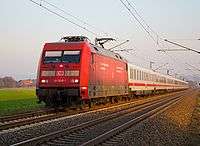
.jpg)